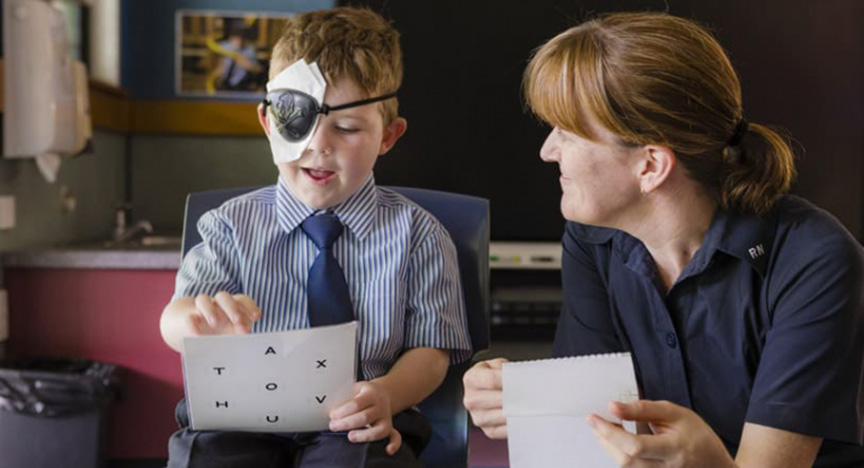
The first year of school is a major milestone in every child’s life (OK, their parents, too). It’s their first step into the big world of formal learning and one that sets them up for the rest of their school years. To ensure children get the best start on their journey there’s arguably nothing more vital than their eyesight. A vision screening takes just five minutes, but the benefits can last a lifetime. Here’s why it should be on the ‘to do’ list of every Preppie parent.
Why is vision screening at Prep age so important?
Good vision is essential for a child’s learning and development. Their eyes are constantly in use in the classroom and at play, and if there is a problem it can potentially have long-lasting effects on a child’s social and educational development.
“If they can’t see what’s on the blackboard, and can’t make out the words in their reading books, they can start to fall behind in their learning quickly,” says Shelley Duffy, manager of Children’s Health Queensland’s free statewide vision screening program for Prep students. This year, the program will offer vision screening to more than 60,000 prep students in their schools.
“If a vision issue is not detected, it can lead to difficulties with concentration and behavioural issues in the classroom.
“Children’s eyes mature up until the age of eight, so early detection of any issues and treatment offers the best opportunity to address problem eye conditions and keep them on track to reach their full potential,” she said.
What conditions can vision screening detect?
Myopia (short-sighted): If your child has myopia, far-away objects seem blurry. They might need to squint or partially close their eyes to see objects in the distance clearly.
Hyperopia (long-sighted): If your child has hyperopia both their distance and near vision are blurred though they have more difficulty focusing on objects that are up close.
Astigmatism: Astigmatism is an eye problem where the front surface of the eye isn’t curved properly, or the lens of the eye is an irregular shape causing blurred vision.
Strabismus (squint/turned eye): Children with strabismus have eyes that seem to look in different directions. Strabismus can lead to problems with vision in the turned eye and a condition called ‘amblyopia’ (see below).
Amblyopia (lazy eye): Amblyopia is decreased vision in one or both eyes due to abnormal development early in life. This is the most common cause of visual impairment in Australian children, affecting about two in every 100 children. In severe cases, amblyopia can even cause blindness if not treated early.
Common signs that your child might need an eye test
If your child’s vision is not working properly, they may have:
- sore eyes;
- tiredness and headaches;
- difficulties with their education, behaviour and coordination;
- trouble concentrating;
- difficulties with activities that need close vision like reading.
“Another tell-tale sign that your child might be experiencing vision problems, is if they start avoiding activities that require distance vision, such as sports,” Shelley advises.
“Kids rarely report vision problems, so it’s important for parents to be aware of the signs and get help early. It can make such a difference to a child’s life.”
Take Evie, for example, who was found to be short-sighted after a vision screen.
She had been struggling to keep up with reading and writing in her first year at school, and she easily became overwhelmed by new surroundings.
“We weren’t aware of any problems with Evie’s vision before the screening, but her new glasses completely changed her life,” her mum Erin said.
“Now she loves going to school and socialising, her schoolwork and behaviour has improved dramatically, and she enjoys participating in more outdoor activities, like bike riding and playing at the park.”
What happens during a vision screening?
The simple five-minute assessment is carried out by a Registered Nurse at your child’s school. The nurse will use two non-invasive screening tools to check your child’s vision including:
- A handheld screening device which takes a picture of your child’s eyes. Your child will be asked to sit still and look into the device while the picture is taken.
- Letter matching cards. Your child will be asked to read the letters aloud to test their visual acuity (ability to see shapes and detail).
What happens if a problem is detected?
If a vision concern is found with your child’s vision, the nurse will contact you to provide advice about seeking further assessment with an optometrist or ophthalmologist.
Protecting your child’s eyes
The Australian Government Department of Health guidelines recommend the following advice about screen time for children:
- 0-2 years. No screen time.
- 2-5 years. One hour recreational screen time per day.
- 5-17 years. 2 hours recreational screen time per day.
Two hours of daily outdoor play while maintaining sun safety is also recommended.
‘Keep an eye’ on your child’s vision
“It’s important to remember that new problems can still occur after your child has had a screening test, so it’s important to monitor your child’s vision as they grow, be aware of the signs that something might be wrong, and get them checked if needed,” Shelley said.
If you have concerns about your child’s eyes at any time, please make an appointment for your child to see an eye health professional.